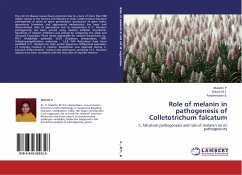The red rot disease causes heavy economic loss to a tune of more than 500 million rupees to the farmers and industry in India. Colletotrichum falcatum pathogenesis in terms of spore germination, production of germ tubes, appressoria formation and appressorial melanization has been well demonstrated. Role of appressoria and its melanization in C. falcatum pathogenicity has been proved using melanin inhibitor tricyclazole. Specificity of melanin inhibitors was proved by comparing the azole and nonazole fungicides. Three genes responsible for melanin biosynthesis viz., PKS1 (Polyketide synthase), SCD1 (Scytalone dehydratase), THR1 (trihydroxynaphthalene reductase - 1,3,8 THN Reductase) have been amplified in C. falcatum for their partial sequences. Differential expression of enzymes involved in melanin biosynthesis was observed during C. falcatum differentiation. Cultural and pathogenic variability of C. falcatum isolates have been correlated with the induction of mycelial melanin.








